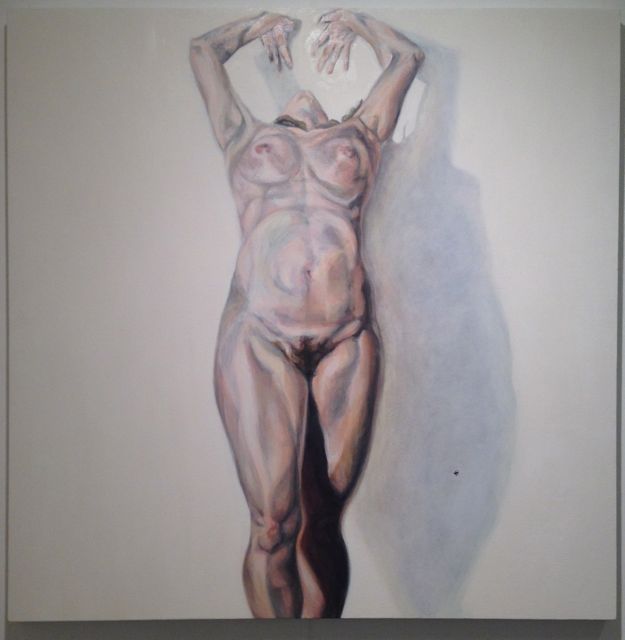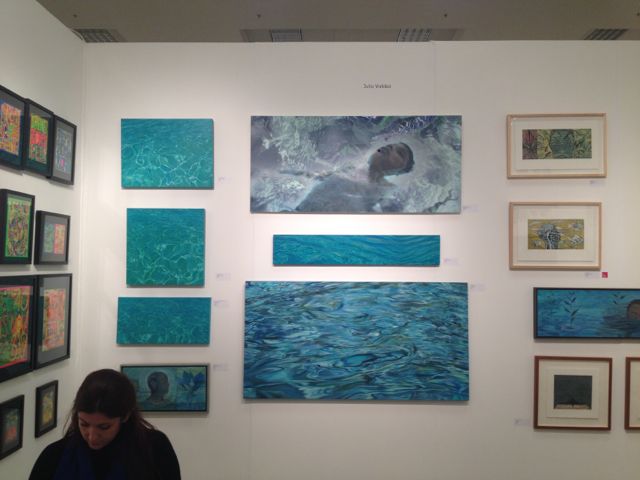Omphaloskepsis Blog
How artists go to art fairs
Dec 24, 2013

Kim Anderson, "Reflex" (thumbnail) and "Adjust" @ C. Emerson Fine Arts
I get nervous in galleries. If I meet the gallery owner, I start talking and can’t shut up. Lordy knows what comes out of my mouth. Last time I went into a gallery I went on and on about dental appointments, redheads and anesthesia. Wow. I’m sure I looked smart and clever and put together! That’s one reason why an art fair, such as The Affordable Art Fair that just closed here in Seattle, is a great way to see art, interact with galleries, and eavesdrop!

Affordable Art Fair, Seattle. Sunday, November 10.
I watched Amy Cuddy’s TED talk that had a lot of impact on me, mostly because it made sense and was backed up by science. It talked about power poses, how they lower cortisol and increase testosterone in your body. Two minutes is all their study subjects needed prior to an interview in order to be perceived as (and present as) more genuine. I taught my daughters and I practice them, especially when I’m going into a situation that makes me nervous.
If you’re like me, an emerging artist, an artist who feels intimidated by galleries, an artist on a quest to learn more about her business-you may not want to miss the next art fair.

Here I'm noticing how this gallery inexpensively presented this art mounted on foamcore. @ Place Contemporary
When I say art fair, I’m not talking about the kind where artisans have booths, I’m talking about the kind where real collectors and galleries get together to do business.
I must admit, I have long been outspokenly against art fairs. I felt it degraded the work, fed into the commodification of art and took away from its higher calling. I felt art fairs lent themselves to decoration. It’s not that those things are no longer true, its just that I don’t see it in such black and white terms anymore.


Jason Snyder @ C. Emerson Fine Arts
Before stepping foot in The Affordable Art Fair (Affordable, by the way, is classified as art under 10 grand), I asked myself: Why am I going? What do I hope to gain from attending? It was great to run into some of my artist friends at the fair and ask them as well.

Claire Brandt, "Bend"
Sculptor Tom Mattausch told me he just comes to see good work and get inspired.
Fiber and installation artist Suzanne Tidwell said: Elaborated on that topic, pointing out that seeing the work in person, rather than digitally, is critical to her. The scale, texture, and colors just can’t be duplicated online. She also added that looking at art at an art fair v. looking at art in a gallery is much less intimidating. The galleries seem more approachable.
Painter and conceptual artist Akiko Masker had a systematic and well thought out approach. She was listening to get an idea of how galleries interact with their customers, how they promote their artists, and how they present the work. Like me, she gets verbose in a gallery, therefore finds the art fair format much less intimidating.

Ellen Dieter, "Arboreal" @ Sergo Contemporary Art Alliance
Understanding where you fit in in the market is key to moving your career ahead. Is key to being able to speak intelligently about your work with potential buyers, curators and gallerists.




(Top to bottom) Julio Valdez Studio. Kathleen Wilke C. Prints, Eric Zener @ Davidson Galleries, Jennifer Beedon Snow, "Poolside Chairs" @ Linda Hodges Gallery
Here are the things I’m looking for:
- Determine if my work can fit in and if so, where it might fit in.
- Who is my “competition?” Who makes art similar in some way to mine?
- Make note of those artists. Look at the galleries that represent them and their oeuvre of artists. Look up the c.v.s of the artists who’s work is like mine. Where else do they exhibit? Who’s written about them? What kinds of grants have they received? How do they price their work? Who is the audience for their art? Would that be similar to the audience for your work? What is the reaction to that work from the audience?
- Selective eavesdropping. Respectfully and inconspicuously listen in. What is the audience saying? How are the gallerists’ portraying the work? What are the key words or buzz words they’re using?
- Presentation: How are artists and galleries presenting the work? What are the production values of the presentation: mounting, finishes, lighting, labels, display, framing, etc. Is there room for me to improve in this area? At the Affordable Art Fair, I overheard Bryan Ohno talking about his approach to displaying his gallery’s work. He said that he made a mock up of the space prior to set up. That made installation smooth. Once the centerpiece was up, the rest of the art quickly flowed around it. That sounded like a reasonable, time-saving approach to me.
- Promotional materials: what are the galleries offering? What gets included and what gets left out?


Dinh Thi Tham Poong @ Vietnamese Contemporary Fine Art, "Family" and "Heart of the Lotus" JHDArtAsia@aol.com
Smile and be respectful of the gallery’s time. They paid to be there and their primary objective is to make sales. Do not approach a gallery at an exhibit and ask for representation, hand them your portfolio or pump them with questions about the business. You won’t be doing yourself any favors. If you do connect with a gallery and you think it would be a good fit AND they seem receptive, ask them if you can contact them in 2 weeks to follow up with them. Be transparent and genuine.




(Top to bottom) John White, Birds on a Wire Series @ Silvia White Gallery, Michelle Mikesell @ Decorazon, Darlene Cole, "Brave as a bear" @ Foster White, Chris Wood, "ordered chance," @ Byard Art
Some other blogs you may like:
 MENU
MENU